By Geoff Gehman ’80
Once upon a time, in a hipper, hippier age, the brothers of Phi Kappa Psi put a sly psychedelic spin on the venerable tradition of trash-talking Lafayette’s football archenemy. During the day the fraternity’s electrified sign read “Lehigh Should Die”; at night it read “LSD.” Those three glowing letters allowed the Phi Psis to tweak both The Rivalry and The Establishment.
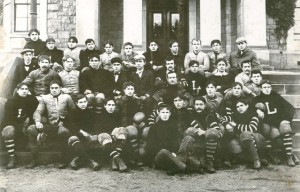
The 1896 national championship football team posted an 11-0-1 record and defeated Penn, the College’s greatest football triumph to that point. Photo courtesy of Lafayette Special Collections.
This snappy story, supported by a photograph, surfaced during Friday’s Reunion College sessions touching on the history of 170-odd years of Lafayette athletics. Led by archivist Diane Shaw and associate archivist Elaine Stomber ’89, the tour was surprising and surprisingly inspiring. It served as an archival pep rally for November’s 150th game against Lehigh at Yankee Stadium, only the second neutral-site game in college football’s most-played rivalry.
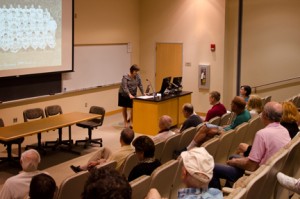
Diane Shaw tells some of the early tales of Lafayette’s storied athletic history.
Friday’s program included much, naturally enough, about The Rivalry. In 1891 the football teams played each other three times, once in Wilkes-Barre, the only neutral site meeting so far. In 1896 the game was canceled because Lehigh officials insisted that Lafayette halfback George “The Rose” Barclay had violated his college eligibility by playing semi-pro baseball for a summer. The same year, Lafayette defeated mighty Penn, 6-4, in Philadelphia. The College’s greatest football triumph to that point, it propelled the Maroons to their first national championship, and the Rose received national attention for inventing the football helmet to protect his ears.
Lehigh won the 1914 contest, largely because Lafayette’s best players were benched by typhoid fever. Lehigh slaughtered Lafayette, 78-0, in 1917, the year America entered World War I. In 1921 and 1926, Lafayette exacted sweet revenge by beating Lehigh to complete undefeated seasons and win the national championship.
Lafayette’s best-known game was never played. College leaders refused an invitation to the 1949 Sun Bowl in El Paso after bowl leaders refused to break Texas segregation laws by permitting David Showell ’51, a black halfback and former Tuskegee Airman, to play. The decision triggered a massive protest against racial discrimination by College students, some of whom sent a telegram to President Harry S. Truman. It was, as Shaw pointed out, one of Lafayette’s first civil-rights demonstrations.
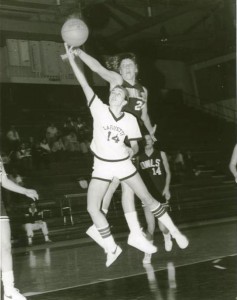
Janet Murray ’80 plays during her senior year. Photo courtesy of Lafayette Special Collections.
Shaw and Stomber discussed plenty of non-football teams and stars, too. Al LeConey ’23 shared a gold medal in the 4×100-meter relay race in the 1924 Paris Olympics, a victory chronicled in the 1981 movie Chariots of Fire. Janet Murray ’80, a member of the Maroon Club Athletic Hall of Fame, never played on a losing team while captaining softball, basketball, and field hockey. The field hockey squad has won 11 Patriot League championships, a far cry from early years of co-ed neglect, when female players had to share jerseys.
There was enough arcana to start a Lafayette Bowl of Sports Trivia. Who knew that the College’s first intercollegiate baseball game, played in 1869 against—who else?—Lehigh, finished in a 45-45 tie, a great football score. Or that the first gymnasium, finished in 1874 on the current site of Kirby Hall of Civil Rights, resembled a Victorian church? Or that fabled athlete Jim Thorpe finished third in a 100-yard dash on College Hill in 1912, the year he won a gold medal in the Olympic decathlon? A photo of Thorpe losing the race debunked the marvelous myth that he defeated the entire Lafayette track team by himself.
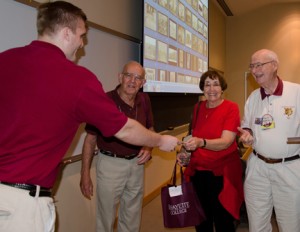
Brad Bormann ’14 (left) encourages alumni to contribute their favorite Lafayette-Lehigh memory to the My Rivalry project.
The encyclopedic information impressed a pair of Lafayette football players. Brad Bormann ’14, an offensive guard who was named Maroon Club Scholar-Athlete of the Year and won the Pepper Prize, enjoyed “the depth and breadth” of the photos, including one of a cigar, the Lafayette Stonewall, created to celebrate the 1896 win that ended Penn’s 66-game winning streak.
His linemate, Garrett McNally ’15, couldn’t believe the breadth and depth of The Rivalry’s passion. He was particularly intrigued by a 1968 photo of Lafayette players wearing “Beat Lehigh” on their uniforms and a 1950s photo of Lafayette students shaving “L’s” into the hair of Lehigh students caught tampering with Lafayette’s pregame bonfire.
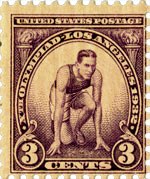
A photograph of Al LeConey ’23 was used by the U.S. Postal Service for a 1932 Los Angeles Olympics commemorative stamp. Photo courtesy of Lafayette Special Collections.
Older graduates suggested ways of spreading this information to strengthen Lafayette’s athletic reputation. John Colton ’64, who as a sophomore played on an undefeated, title-winning tennis team, said the College should publicize its historic sports firsts. One of the “selling points” could be the invention of the huddle by football coach Herb McCracken in 1924 to prevent opposing teams from stealing plays.
Bob “Whitey” White ’64 was inspired by Lafayette’s long-ago football glory. He’s thinking of listing the years of the College’s national championships—1896, 1921, 1926—on a jacket he would wear during the historic 150th game at Yankee Stadium. The message, he believes, would make his Lehigh friends maroon with envy.
Jim Flowers ’69 just wants the Lafayette baseball team to play in the College World Series in Omaha, where he’s lived for 34 years. The last time that happened was 1965, the year he entered Lafayette as the grandson of a College forge-work instructor who used a planer to flatten a baseball bat into a paddle for punishing fraternity pledges. For now Flowers will accept watching the 150th football game on TV with fellow Lafayette grads in Omaha.
On Saturday the College videotaped alums’ reminiscences of The Rivalry. Chris Luick ’09 decided to focus on a more personal rivalry in another sport. He played first base on Lafayette’s 2007 Patriot League championship baseball team with pitcher John Fugett ’07, who settled on the Dark Side when he began serving as the assistant baseball coach at Lehigh.
“We’re constantly talking trash to him,” said Luick, a Major League Baseball marketing producer who helped coordinate ticket sales for the game at Yankee Stadium. “He won’t hear the end of it until he stops coaching at Lehigh.”




